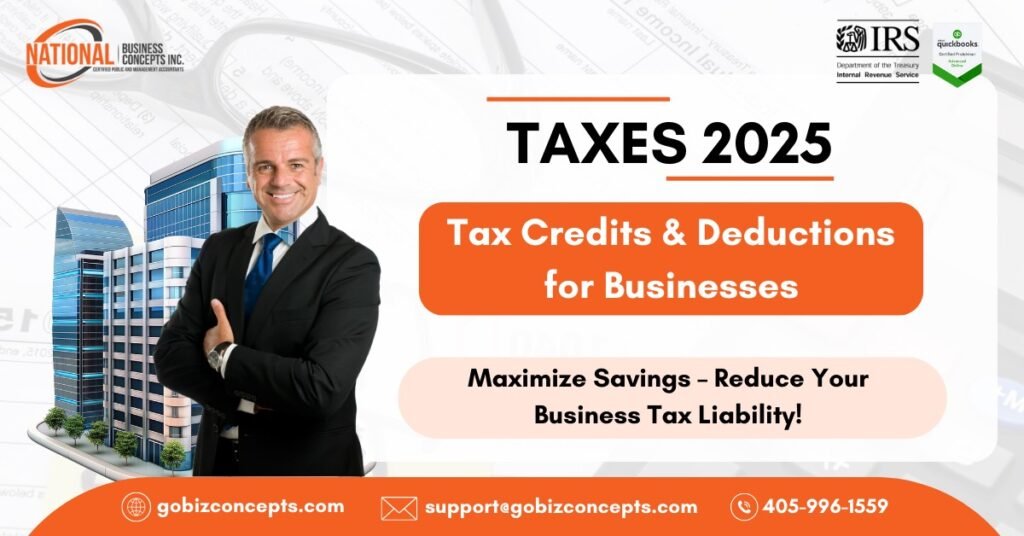What Are Deductions (EBT) & Tax Credits For Businesses
According to the IRS, businesses can take advantage of various deductions and tax credits to reduce their tax liability. Applying the deductions results in the line item on an income statement called earnings before taxes (EBT,) or, in other words, the business tax liability. Credits can be used to reduce this tax liability.
After determining their sales revenue, to establish their tax liability, businesses can deduct business expenses that are ordinary and necessary for running the business, such as rent, utilities, office supplies, and salaries; depreciation, i.e., the decrease in value of an asset due to obsolescence or use; home office deduction, i.e., home expenses if the part of a home is used exclusively for business purposes; vehicle use expenses, using standard mileage rate or actual expenses; business-related travel expenses, including airfare, lodging, and meals; interest expenses on business loans; business insurance premiums; employee benefits such as health insurance and retirement plans; startup costs, to a limit, incurred in starting a new business; and Qualified Business Income Deduction (QBI,) also called the Section 199A deduction, up to 20% of qualified business income.

To reduce tax liability businesses can apply tax credits such as the Work Opportunity Tax Credit (WOTC), a credit for hiring individuals from certain targeted groups who face barriers to employment; expenses related to research and development (R&D); credit for small businesses that provide health insurance to their employees called the Small Business Health Care Tax Credit; credit for businesses that provide childcare facilities for their employees, i.e., the Employer-Provided Childcare Credit; Energy Efficient Commercial Building Deduction for making energy-efficient improvements to commercial buildings; Disabled Access Credit for expenses incurred making a business accessible to the disabled; credit for Employer Security and Medicare Taxes Paid on Certain Tips; credit for Small Employer Pension Startup Costs; Fuel Tax Credit for fuel used in specific work-related activities; and Clean Vehicle Credit for purchasing electric or fuel cell vehicles for business use.

Comparison With 2023-2024 Tax Season
Deduction changes for 2024/205 are related to Section 179 Expensing, Bonus Depreciation, and Qualified Business Income (QBI.) Section 179, Expensing of the Internal Revenue Code allows businesses to deduct the full purchase price of qualifying equipment and software in the year they are placed in service, rather than depreciating them over several years. This deduction can work in tandem with Bonus Depreciation. The limit for Section 179 expensing has increased to $1.16 million, adjusted for inflation annually. This deduction can provide significant tax savings and improve cash flow for businesses.
Bonus depreciation, also known as the additional first-year depreciation deduction, is a tax incentive that allows businesses to immediately deduct a significant portion of the cost of eligible assets in the year they are placed in service. This is instead of spreading the deduction over the useful life of the asset through regular depreciation. In 2024/2025, bonus depreciation on assets drops to 40% and will phase out by 2027.
The Qualified Business Income (QBI) Deduction, also known as the Section 199A deduction, allows eligible self-employed individuals and small-business owners (owners of pass-through businesses such as sole proprietorships, partnerships, S corporations, and some trusts and estates or Specified Service Trade or Business (SSTB)) to deduct up to 20% of their qualified business income on their taxes. This deduction was introduced as part of the Tax Cuts and Jobs Act (TCJA) of 2017 and is available for tax years beginning after December 31, 2017, and ending on or before December 31, 2025.
Changes were made in tax credits for 2024/2025 for energy efficiency, research and development, small employer health insurance premiums, and employee retention. Under the Energy Efficiency Credit, there are expanded credits for installing energy-efficient systems, such as solar panels or EV charging stations, in commercial properties. The Research and Development (R&D) Credit clarifies eligibility for smaller businesses. The Small Employer Health Insurance Premium Credit provides updated thresholds for health insurance to employees. The Employee Retention Credit (ERC) was phased out for most taxpayers, however, businesses affected by significant natural disasters or economic downturns should be vigilant for potential extensions.
Notes
The corporate tax rate varies depending on the type of business and its location:
C-Corporations:
- United States: The federal corporate tax rate is a flat 21%.
S-Corporations:
- United States: S-Corporations themselves are not taxed at the corporate level. Instead, income is passed through to shareholders and taxed at their individual tax rates.
Partnerships:
- United States: Partnerships are not taxed at the entity level. Instead, income is passed through to partners and taxed at their individual tax rates.
Limited Liability Companies (LLCs):
- United States: LLCs can choose to be taxed as a sole proprietorship, partnership, S-Corporation, or C-Corporation. The tax rate depends on the chosen tax classification.
Sole Proprietorships:
- United States: Sole proprietorships are not taxed at the entity level. Instead, income is reported on the owner’s individual tax return and taxed at their individual tax rates.
Non-Profit Organizations:
- United States: Non-profit organizations are generally exempt from federal income tax if they meet certain requirements. However, they may be subject to tax on unrelated business income.
Individual Income Tax Rates:
For the 2024-2025 tax season, the income tax brackets and rates have been adjusted to account for inflation. These changes are designed to prevent “bracket creep.” These new rates follow:
- 10% for incomes up to $11,925 (or $23,850 for married couples filing jointly)
- 12% for incomes between $11,926 and $48,475 (or $23,851 and $96,950 for married couples filing jointly)
- 22% for incomes between $48,476 and $103,350 (or $96,951 and $206,700 for married couples filing jointly)
- 24% for incomes between $103,351 and $197,300 (or $206,701 and $394,600 for married couples filing jointly)
- 32% for incomes between $197,301 and $250,525 (or $394,601 and $501,050 for married couples filing jointly)
- 35% for incomes between $250,526 and $626,350 (or $501,051 and $751,600 for married couples filing jointly)
- 37% for incomes over $626,350 (or over $751,600 for married couples filing jointly)
Applicable Tax Credits For Business:
- C-Corporations:
- Research and Development (R&D) Credit
- Work Opportunity Tax Credit (WOTC)
- Energy-Efficient Commercial Buildings Deduction
- S-Corporations:
- Work Opportunity Tax Credit (WOTC)
- Small Business Health Care Tax Credit
- Partnerships:
- Work Opportunity Tax Credit (WOTC)
- Energy-Efficient Commercial Buildings Deduction
- Limited Liability Companies (LLCs):
- Credits depend on the chosen tax classification (e.g., R&D Credit for C-Corporation classification)
- Sole Proprietorships:
- Earned Income Tax Credit (EITC)
- Child and Dependent Care Credit
- Non-Profit Organizations:
- Credits are generally not applicable, but they may qualify for certain grants and incentives.
Forms to complete tax returns:
C-Corporations:
- Form 1120: U.S. Corporation Income Tax Return. This form is used by C-Corporations to report their income, gains, losses, deductions, and credits.
S-Corporations:
- Form 1120S: U.S. Income Tax Return for an S Corporation. This form is used by S-Corporations to report their income, gains, losses, deductions, and credits. Shareholders report the income and deductions on their individual tax returns using Schedule K-1.
Partnerships:
- Form 1065: U.S. Return of Partnership Income. Partnerships use this form to report their income, deductions, gains, losses, etc. Each partner reports their share of the partnership’s income and deductions on Schedule K-1, which they use to complete their individual tax returns.
Sole Proprietorships:
- Form 1040, Schedule C: Profit or Loss from Business (Sole Proprietorship). Sole proprietors use this form to report their business income and expenses on their personal tax returns.
Limited Liability Companies (LLCs):
- Single-Member LLCs: Treated as a disregarded entity, they use Form 1040, Schedule C.
- Multi-Member LLCs: Treated as partnerships, they use Form 1065.
Non-Profit Organizations:
- Form 990: Return of Organization Exempt from Income Tax. Non-profit organizations use this form to provide the IRS with information about their activities and finances.
Employment Taxes:
- Form 941: Employer’s Quarterly Federal Tax Return. This form is used to report income taxes, Social Security tax, and Medicare tax withheld from employees’ pay checks.
Conclusion
Businesses can reduce their tax liability through various deductions and tax credits. Deductions impact the earnings before taxes (EBT) on an income statement, while credits directly reduce the tax liability. Changes for 2024/2025 include updates to Section 179 Expensing, Bonus Depreciation, and Qualified Business Income (QBI) deductions. There are also new credits for energy efficiency, research and development, small employer health insurance premiums, and employee retention. These updates aim to provide financial relief and support to businesses but require careful navigation to ensure proper compliance and accurate filing.
Other Sources
Earnings Before Tax (EBT)
What Is Earnings Before Tax (EBT)? https://youtu.be/ZauenK3AAPI
Corporate Tax: Definition, Deductions, and How It Works: https://www.investopedia.com/terms/c/corporatetax.asp
Income Before Taxes Explained | What Are Pre-Tax Earnings? | Other Income & Expenses: https://youtu.be/CmX9dG7BxuA
Qualified Business Income Deduction: https://www.irs.gov/newsroom/qualified-business-income-deduction
The Qualified Business Income (QBI) Tax Deduction (U.S. Tax): https://youtu.be/tQ7NcdvX2m4
How to Take the 20% QBI Tax Deduction | CPA Explains Section 199A Qualified Business Income: https://youtu.be/DZvQfJOiq7M
How to Calculate Your Startup Costs for Your New Business: https://youtu.be/pACo_F_O4Cc
Startup costs: understanding the costs for your business | Start your business: https://youtu.be/EAx49SZyDkk
How small business owners can deduct their home office from their taxes: https://www.irs.gov/newsroom/how-small-business-owners-can-deduct-their-home-office-from-their-taxes
How to Write Off Your HOME EXPENSES as a BUSINESS! [Home Office Deduction Explained by CPA]: https://youtu.be/rJzcluG2TxM
Home Office Deduction Explained…Write Off Home Office & Save Taxes: https://youtu.be/l7vppoK0IOs
Tax Credits
Tax Credits vs Tax Deductions: What is the Difference and Which is Better? https://youtu.be/farYRlDMk_M
17 Business Tax Credits: https://youtu.be/p-MLg1FY1yU
What are Tax Credits for Business Owners-Business Tax Credits-Form 3800: https://youtu.be/P7Gn3_cGLQ8
How to Get Small Business Tax Credits & Incentives | How We Saved $100,000 on Business Tax Expenses! https://youtu.be/WIYZ0lbxOBU
Work Opportunity Tax Credit: https://www.irs.gov/businesses/small-businesses-self-employed/work-opportunity-tax-credit
The Work Opportunity Tax Credit Benefits Employers: https://youtu.be/AdidUSv9XwU
Research & Development (R&D) tax credit explanation: https://youtu.be/jHRYjsXSKWA
Who Qualifies For The Fuel Tax Credit? – CountyOffice.org: https://youtu.be/ePHF5G8wkOI
EV Tax Credits: Everything You Need to Know for 2024 | Eligibility, Incentive Amount & More: https://youtu.be/zY6XPFEHiqs
The Clean Vehicle Credit (for 2023 and forward): https://youtu.be/D-f49l39deg
Changes 2025
What are the 2024-2025 tax law changes that will affect my business? https://www.taxandaccounting.com/post/what-are-the-tax-law-changes-that-will-affect-my-business
Instructions for Form 4562 (2024): https://www.irs.gov/instructions/i4562
Legislation and Regulations
TITLE 26-INTERNAL REVENUE CODE: https://uscode.house.gov/browse/prelim@title26&edition=prelim
Tax Cuts and Jobs Act (TCJA): https://www.congress.gov/115/statute/STATUTE-131/STATUTE-131-Pg2054.pdf
American Rescue Plan Act (ARPA): https://www.govinfo.gov/content/pkg/PLAW-117publ2/pdf/PLAW-117publ2.pdf
Business Tax Provisions of ARPA (The American Rescue Plan Act of 2021): https://laniganryan.com/news-resources/business-tax-provisions-of-arpa-the-american-rescue-plan-act-of-2021/
American Rescue Plan Act: Relevant Tax Provisions and Grant Packages: https://www.wolfandco.com/resources/alerts/american-rescue-plan-act-relevant-tax-provisions-and-grant-packages/
Inflation Reduction Act (IRA): https://www.govinfo.gov/content/pkg/PLAW-117publ169/pdf/PLAW-117publ169.pdf
Code of Federal Regulations, Title 26: https://www.ecfr.gov/current/title-26
“Coronavirus Aid, Relief, and Economic Security Act” or the “CARES Act”: https://www.congress.gov/116/bills/s3548/BILLS-116s3548is.pdf
“Patient Protection and Affordable Care Act”: https://www.congress.gov/111/plaws/publ148/PLAW-111publ148.pdf


